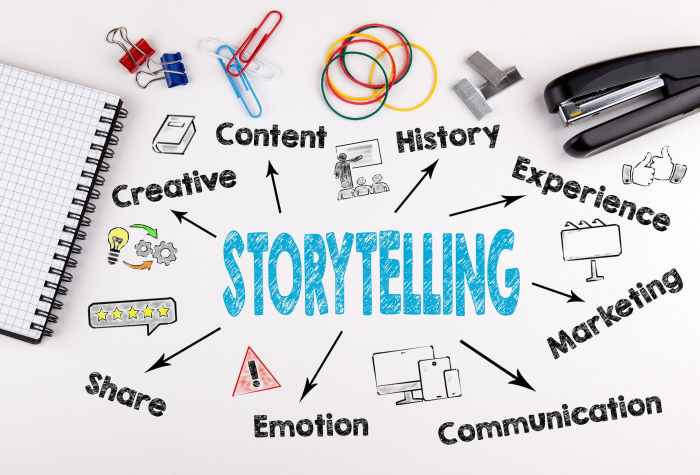Effective Storytelling in Marketing dives deep into the power of storytelling to captivate audiences, build emotional connections, and drive brand success. Get ready to explore the art of storytelling in the world of marketing!
Importance of Effective Storytelling in Marketing
Effective storytelling in marketing is like the secret sauce that makes your brand stand out in a crowded marketplace. It’s not just about selling a product or service; it’s about creating a connection with your audience, engaging their emotions, and building brand loyalty. When done right, storytelling can make your brand memorable and relatable, setting you apart from the competition.
Examples of Successful Marketing Campaigns
- Apple’s “Shot on iPhone” campaign: By showcasing user-generated photos and videos, Apple created a sense of community and authenticity around their brand.
- Dove’s “Real Beauty” campaign: Dove used storytelling to promote body positivity and self-acceptance, resonating with consumers on a deeper level.
- Coca-Cola’s “Share a Coke” campaign: Personalizing their products with individual names sparked a sense of connection and sharing among consumers.
Emotional Connections with Consumers, Effective Storytelling in Marketing
Effective storytelling has the power to evoke emotions like joy, nostalgia, empathy, or inspiration, creating a lasting impact on consumers. When consumers feel connected to a brand on an emotional level, they are more likely to engage with the brand, make repeat purchases, and become brand advocates. By tapping into the emotional side of consumers, storytelling can influence their perceptions, behaviors, and ultimately drive sales.
Elements of Effective Storytelling in Marketing

Effective storytelling in marketing involves several key elements that help captivate the audience and drive engagement. These elements include a compelling narrative, relatable characters, emotional appeal, and a clear message that resonates with the target audience.
Role of Authenticity in Storytelling for Marketing
Authenticity plays a crucial role in storytelling for marketing purposes as it helps build trust and credibility with the audience. By being genuine and transparent in the storytelling process, brands can connect with consumers on a deeper level and establish a lasting relationship based on honesty and integrity.
Incorporating Visuals to Enhance the Storytelling Experience in Marketing
Visuals are a powerful tool in enhancing the storytelling experience in marketing. By incorporating compelling images, videos, and graphics, brands can create a more immersive and engaging narrative that captures the attention of the audience. Visuals help bring the story to life, evoke emotions, and make the message more memorable and impactful.
Strategies for Implementing Storytelling in Marketing

Implementing storytelling in marketing can be a powerful tool to connect with your audience on a deeper level. By incorporating different storytelling techniques and aligning them with your brand’s values and mission, you can create engaging content that resonates with your target market. Here are some strategies to effectively implement storytelling in your marketing efforts:
Different Storytelling Techniques for Marketing Content
- Use the Hero’s Journey: Craft a narrative that takes your audience on a journey, with your brand or product as the hero overcoming challenges.
- Emotional Storytelling: Appeal to your audience’s emotions by sharing stories that evoke feelings of joy, empathy, or inspiration.
- User-Generated Content: Encourage your customers to share their own stories and experiences with your brand, creating authentic and relatable content.
Aligning Storytelling with Brand Values and Mission
- Define Your Brand’s Story: Clearly Artikel your brand’s values, mission, and unique selling points to ensure your storytelling aligns with your overall brand identity.
- Consistency is Key: Maintain a consistent tone and message across all storytelling efforts to reinforce your brand’s identity and build trust with your audience.
- Show, Don’t Tell: Demonstrate your brand values through storytelling by showcasing real-life examples and experiences that embody what your brand stands for.
Understanding Your Target Audience for Crafting Marketing Stories
- Market Research: Conduct thorough research to understand your target audience’s demographics, preferences, and behaviors to tailor your storytelling to resonate with them.
- Create Buyer Personas: Develop detailed buyer personas to help you visualize and empathize with your target audience, shaping your storytelling to address their specific needs and interests.
- Feedback and Iteration: Gather feedback from your audience on your storytelling efforts and use this insight to refine and improve your marketing stories over time.
Impact of Effective Storytelling on Consumer Behavior
Effective storytelling plays a crucial role in influencing consumer behavior, especially when it comes to purchasing decisions. By crafting compelling narratives around a product or brand, marketers can create an emotional connection with consumers, leading to increased engagement and ultimately driving sales.
Influence on Purchasing Decisions
- Storytelling can tap into the emotions of consumers, making them more likely to remember and resonate with a brand.
- When consumers feel a personal connection to a brand through storytelling, they are more inclined to choose that brand over competitors.
- Compelling stories can highlight the unique value proposition of a product, making it stand out in a crowded market and influencing purchase decisions.
Impact on Brand Loyalty
- Case studies have shown that brands with strong storytelling capabilities tend to have higher levels of customer loyalty.
- Storytelling helps in creating a consistent brand narrative that resonates with consumers, leading to long-term brand loyalty.
- By continuously engaging consumers through storytelling, brands can build trust and loyalty, resulting in repeat purchases and advocacy.
Community Building around a Brand
- Storytelling has the power to bring consumers together around a shared narrative, creating a sense of community among brand followers.
- When consumers feel connected to a brand through storytelling, they are more likely to engage with other like-minded individuals, fostering a community of brand advocates.
- Building a community around a brand through storytelling can lead to increased brand awareness, word-of-mouth referrals, and overall brand success.
